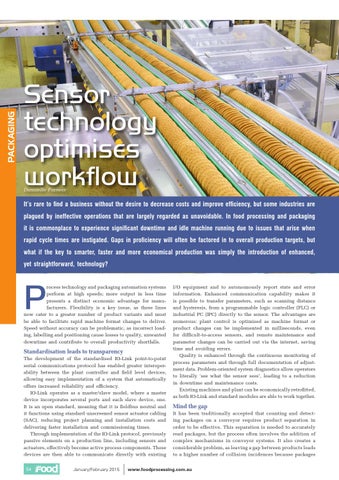PACKAGING
Sensor technology optimises workflow Dannielle Furness
It’s rare to find a business without the desire to decrease costs and improve efficiency, but some industries are plagued by ineffective operations that are largely regarded as unavoidable. In food processing and packaging it is commonplace to experience significant downtime and idle machine running due to issues that arise when rapid cycle times are instigated. Gaps in proficiency will often be factored in to overall production targets, but what if the key to smarter, faster and more economical production was simply the introduction of enhanced, yet straightforward, technology?
P
rocess technology and packaging automation systems perform at high speeds; more output in less time presents a distinct economic advantage for manufacturers. Flexibility is a key issue, as these lines now cater to a greater number of product variants and must be able to facilitate rapid machine format changes to deliver. Speed without accuracy can be problematic, as incorrect loading, labelling and positioning cause losses to quality, unwanted downtime and contribute to overall productivity shortfalls.
Standardisation leads to transparency The development of the standardised IO-Link point-to-point serial communications protocol has enabled greater interoperability between the plant controller and field level devices, allowing easy implementation of a system that automatically offers increased reliability and efficiency. IO-Link operates as a master/slave model, where a master device incorporates several ports and each slave device, one. It is an open standard, meaning that it is fieldbus neutral and it functions using standard unscreened sensor actuator cabling (SAC), reducing project planning and installation costs and delivering faster installation and commissioning times. Through implementation of the IO-Link protocol, previously passive elements on a production line, including sensors and actuators, effectively become active process components. These devices are then able to communicate directly with existing 54
January/February 2015
I/O equipment and to autonomously report state and error information. Enhanced communication capability makes it is possible to transfer parameters, such as scanning distance and hysteresis, from a programmable logic controller (PLC) or industrial PC (IPC) directly to the sensor. The advantages are numerous: plant control is optimised as machine format or product changes can be implemented in milliseconds, even for difficult-to-access sensors, and remote maintenance and parameter changes can be carried out via the internet, saving time and avoiding errors. Quality is enhanced through the continuous monitoring of process parameters and through full documentation of adjustment data. Problem-oriented system diagnostics allow operators to literally ‘see what the sensor sees’, leading to a reduction in downtime and maintenance costs. Existing machines and plant can be economically retrofitted, as both IO-Link and standard modules are able to work together.
Mind the gap It has been traditionally accepted that counting and detecting packages on a conveyor requires product separation in order to be effective. This separation is needed to accurately read packages, but the process often involves the addition of complex mechanisms in conveyor systems. It also creates a considerable problem, as leaving a gap between products leads to a higher number of collision incidences because packages
www.foodprocessing.com.au
